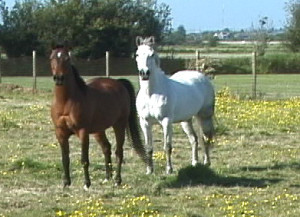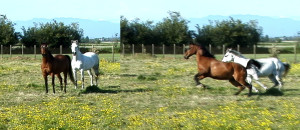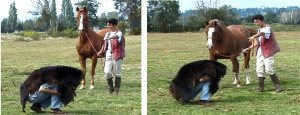Playing – with knowledge – Part 10
|
|
Fachmännisch spielen – Teil 10
|
Exploration behaviour
- In the last part we discussed point 5 (show the right reactions) and point 6 (be determined) of our leadership qualities’ list. On we go!
7. LEAD and let’s explore!
- A leader, who is constantly afraid himself, is clearly no good. So you must prove to your horse that you are more knowledgeable than him in all situations where he has doubts and asks for guidance.
Exploration distance:
- Horses have an innate “exploration distance”. By this I mean the distance to which a perceived danger may approach without triggering an instant flight response. In unknown situations this will be approximately 100 metres, in familiar surroundings more like 20 metres. If the danger comes closer than that, they will quickly turn and be in full flight.
Flight distance:
- They will then run in a straight line and with fast tempo until they have put enough distance between them and the perceived danger. This is usually about 400 to 600 metres, after which they stop, turn around and see if there still IS a reason to continue running. We already know that flight animals will always preserve energy (for the next necessary flight) when possible.
Exploration behaviour – phase 1 from afar:
- The “exploration behaviour” of horses is anchored in their genes and the course of events is always the same. At first this happens at the above mentioned exploration distance, i.e. they take their bearings from afar. For this they mainly use their senses of sight, hearing and smell. If you are observant you will easily recognize the tell-tale signs in your horse’s body language: his body is tensed and ready for flight, head high, back hollowed and his tail held high. His ears are pointed to the front, his eyes will be wide open, and his nostrils extended. Perhaps he will also snort.
|
|
Erkundungsverhalten
- Im letzten Teil diskutierten wir Punkt 5 (richtige Reaktionen zeigen) und 6 (entschlossen sein) unserer Führungsqualitäten. Weiter gehts!
7. Erkundung anleiten!
- Ein Anführer der selbst Angst hat ist nicht viel wert. Man muß also seinem Pferd klarmachen, daß man in allen Situationen, wo es sich beunruhigt und Zweifel hat und um Anleitung fragt, mehr weiß als es.
Erkundungsdistanz:
- Pferde haben eine angeborene „Erkundungsdistanz“. Damit meinen wir die Entfernung, auf die eine vermutete Gefahr sich annähern darf, ohne sofort den Fluchtreflex auszulösen. In ungewohnten Situationen sind das etwa 100 Meter, in vertrauter Umgebung eher 20. Wenn die Gefahr näher als das kommt, machen die Pferde auf der Stelle kehrt und flüchten mit hohem Tempo.
Fluchtdistanz:
- Dann rennen sie auf einer geraden Linie so schnell sie können, bis sie denken, daß sie genug Abstand zwischen sich und die vermutete Gefahr gelegt haben. Das sind normalerweise zwischen 400 und 600 Meter, wonach sie stoppen und sich umdrehen, um festzustellen, ob es Grund gibt, weiter zu flüchten. Wir wissen ja schon, daß Fluchttiere wenn möglich immer ihre Energie (für die nächste nötige Flucht) aufsparen.
Fernorientierung:
- Das „Erkundungsverhalten“ von Pferden ist in ihren Genen verankert und der Ablauf ist immer der selbe. Zuerst passiert es in der oben erwähnten Erkundungsdistanz, d.h. sie orientieren sich aus der Ferne. Dafür nutzen sie hauptsächlich ihren Gesichts-, Gehör- und Geruchssinn. Sie können leicht die typischen Anzeichen der Fernorientierung in der Körpersprache Ihres Pferdes beobachten: sein Körper ist gespannt und fluchtbereit, der Kopf hoch, Rücken weggedrückt und der Schweif aufgestellt. Die Ohren sind nach vorn gespitzt, Augen aufgerissen und die Nüstern gebläht. Vermutlich schnaubt es auch.
|
 The leadmare (left) is in the front to check out the danger, first from a safe distance.
Die Leitstute (links) leitet die Fernerkundung aus der vorderen Reihe ein.
|
Phase 2, from up close:
- When the danger has passed, or the horses have recognized that a threat does not exist, then they go back to business as usual (grazing, dozing), except if they have become curious and want to explore further. If that is the case then the exploration will be lead by the high-ranking animals – that is YOU! The leader! Therefore you must know how it is done.
- Your horse will still be ready for flight, but is willing to approach closer with jerky starts and stops to a certain distance, where he then starts to circle around the worrying object with a long extended neck.
- His body language is very different now from what is was before: he will move head and neck up and down in succession, and twist and turn them to get a full view of the object from all angles. (Read the earlier Blogs about how the horses’ eyes work!) He will snort too!
- In my films “Playing with Horses” (in the chapter about de-spooking them) we caught this on camera beautifully, where my horses are invited to inspect a fake bear.
- During this phase the horse relies mostly on his sense of smell – and only when he dares to go really close also the sense of touch. He may pound it with his hoof or explore with his tactile hairs (whiskers), and may also lick, i.e. taste the object.
|
|
Phase 2 – Nahorientierung:
- Wenn die Gefahr vorbei ist, oder die Pferde erkannt haben, daß es keine Bedrohung gibt, dann gehen sie wieder ”zur Tagesordnung” über (fressen, dösen), außer, wenn sie neugierig geworden sind und weiter erkunden wollen. Wenn das der Fall ist, wird die Erkundung von den hoch-rangigen Tieren eingeleitet – das sind SIE! Der Anführer! Daher müssen sie wissen, wie man es macht.
- Ihr Pferd ist immer noch fluchtbereit, aber gewillt sich weiter anzunähern, mit ruckartigen Starts und Stopps, bis auf eine gewisse Distanz, wo es anfängt, das Objekt mit langem Hals zu umrunden.
- Seine Körpersprache ist nun ganz anders als zuvor: Kopf und Hals werden abwechselnd gehoben und gesenkt und gedreht und gewendet, um ein klares Bild des Gegenstandes aus allen Blickwinkeln zu erhalten. (Aus den früheren Blogs wissen Sie, wie die Augen eines Pferdes funktionieren!) Auch hierbei wird geschnaubt!
- In meinen Filmen „Playing with Horses“ (auch deutsch! Im Kapitel über Ent-scheuen) haben wir das wunderbar mit der Kamera eingefangen, als meine Pferde einen falschen Bären untersuchten.
- In dieser Phase verläßt sich das Pferd hauptsächlich auf seinen Geruchssinn – und nur wenn es sich wirklich dran wagt, auch auf seinen Tastsinn. Vielleicht klopft es mit dem Huf daran oder untersucht es mit seinen Tasthaaren – vielleicht leckt es das Objekt gar.
|
 After checking out the danger from afar, the leadmare decides to flee – the others follow simultaneously!
Nachdem sie die Gefahr aus der Ferne eingeschätzt hat, beschließt die Leitstute zu flüchten – die anderen folgen sofort! |
The biggest leader mistake:
- We mentioned many times that only a self-assured horse can feel safe and therefore happy, and that it is our job as leader to make becoming more courageous possible for him. What a HUGE mistake is it therefore, if you try to just lead him by a perceived danger, demanding obedience, while your entire behaviour is, in HIS eyes, un-leader-like and dangerous!
- If you don’t LEAD the necessary exploration knowledgeably and according to HIS rules, then the danger persists (because you haven’t checked it out!). If you now just try (possible with whip and threats) to force him by, you have proven to NOT be a good leader. But if you also “turn tail” by avoiding the problem altogether (like so many humans do!) he will understand that as a sign of fright (and will be mostly right!) – in both cases you will lose your horse’s trust as a direct consequence.
|
|
Der größte Anführer-Fehler!
- Wir haben oft erwähnt, daß nur ein beherztes Pferd sich sicher fühlen und daher glücklich sein kann. Es ist Ihr Job als Anführer es ihm möglich zu machen, daß es mutiger werden kann. Daher ist es ein Riesenfehler, wenn Sie es an einer vermuteten Gefahr einfach vorbeiführen wollen, indem Sie Gehorsam fordern, während doch Ihr ganzes Verhalten, in SEINEN Augen, schlecht geleitet und gefährlich ist!
- Wenn Sie die nötige Erkundung nicht fachmännisch anführen (und das nach SEINEN Regeln!) dann besteht die Gefahr weiter, da Sie sie ja nicht untersucht haben! Wenn Sie nun versuchen (vielleicht dazu noch mit Peitsche und Drohungen) das Pferd vorbei zu zwingen, haben Sie ihm stichhaltig bewiesen, daß Sie kein vertrauenswürdiger Führer sind. Wenn Sie aber selber ausreißen, indem Sie das Problem ganz vermeiden (was die meisten Menschen tun), dann wird es das als Zeichen Ihrer Angst interpretieren (und vermutlich Recht haben!) – in beiden Fällen verlieren Sie sein Vertrauen als direkte Konsequenz.
|
 Left: Beau has reached the limit between exploration from afar and closer up: he is clearly less curious than I am!
Right: the typical flight posture: Head and tail high, back hollowed – here full speed ahead!
Links: Beau hat die Grenze zwischen Fern- und Naherkundung erreicht. Er ist eindeutig weniger neugierig als ich!
Rechts: die typische Fluchthaltung: Kopf und Schweif hoch, Rücken durchgedrückt – hier volles Tempo und ab gehts!
|
How to do it:
- In the film “Playing with Horses” you see a scene, where the mare Gloria is lead to an extremely worrying silver umbrella – and it is really touching, how she looks at her leader with every step she takes asking for reassurance.
- Therefore: YOU introduce the exploration and LEAD the horse to the worrying object, while allowing him to go through all the stages of exploration, which are necessary by his instincts!
- When the exploration from up close has been completed watch for signs of calm in his body language, such as dropped neck with ears attentive to the front, calm chewing, relaxed tail and gentle snorts.
|
|
Was also tun:
- In den Filmen “Playing with Horses” sehen Sie eine Szene, wo die Stute Gloria zu einem sehr beunruhigenden silbernen Schirm geführt wird – und es ist wirklich rührend, wie sie immer wieder auf ihre Anführerin blickt, um sich bei jedem Schritt rückzuversichern.
- Daher: SIE leiten die Erkundung ein und FÜHREN das Pferd zu dem beunruhigenden Objekt, indem Sie ihm aber alle Stadien der Erkundung erlauben, die es seinen Instinkten nach benötigt!
- Wenn die Nahorientierung erfolgt ist, beobachten Sie die Anzeichen in seiner Körpersprache, wie ein fallengelassener Hals mit aufmerksamen Ohren nach vorne, ruhiges Kauen, entspannter Schweif und Abschnauben.
|
 Peter is in the first stage of exploring up close: he circles the object (left) – then decides it is safe to come closer (right)
Peter ist hier (links) in der ersten Phase der Naherkundung: er umrundet den Bär – dann beschließt er näher zu kommen (rechts) |
Leading does not mean being over-protective!
- Make your horse curious by giving him reassurance, rather than avoiding worrisome situations – he interprets that as being fearful and concludes that you have no leadership qualities. Identify the problems and solve them! In the end this makes everything safer for you and everybody around! You have to prove to your horse that there is nothing to worry about, if you want to keep him from spooking.
- You do not have to fear that the rest of your life will now be spent exploring from afar and up close and you won’t have time to ride anymore! Your horse will trust you more and more, and if you do not wish to explore you will just signal to him that YOU, with your previous experience, already KNOW that there is no reason to worry – and you can proceed on.
- However! Every time your horse looks at something, you MUST first look too – to make clear to him that you HAVE seen the perceived problem – otherwise how could you know whether it is a threat or not? You would not be credible.
|
|
Anführer sein heißt nicht über-Beschützen!
- Machen Sie Ihr Pferd neugierig, indem Sie es selbstsicher machen, anstatt mögliche Probleme zu vermeiden – es interpretiert dies nur als Ängstlichkeit und schließt daraus, daß Sie keine Führungsqualitäten haben. Identifizieren Sie die Probleme und lösen Sie sie! Das Ergebnis ist große Sicherheit für Sie und die Umgebung. Sie müssen Ihrem Pferd beweisen, daß es keinen Grund zur Unruhe gibt, wenn Sie es „ent-scheuen“ wollen!
- Fürchten Sie nun aber nicht, daß Sie Ihr restliches Leben damit verbringen müssen, mit viel Zeitaufwand alles und jedes von nah und fern erkunden zu müssen! Ihr Pferd wird Ihnen immer mehr vertrauen und es wird genügen, wenn Sie ihm signalisieren, daß Sie, mit Ihrer größeren Erfahrung, schon WISSEN, daß kein Problem besteht.
- Aber! Jedes Mal, wenn Ihr Pferd etwas beunruhigt anschaut, MÜSSEN Sie auch hinschauen – denn Sie müssen ihm mitteilen, daß Sie es ebenfalls gesehen HABEN – wie sonst könnten Sie wissen, ob es eine Bedrohung ist oder nicht? Sie wären nicht glaubwürdig.
|
 I point and encourage the horse, but let him decide when to go closer. He will still vacillate right and left, perhaps circle.
Ich zeige hin und spreche ihm Mut zu, überlasse es aber dem Pferd, wann er näher treten will. Er darf hin und her gehen und umkreisen. |
- NEVER praise your horse for spooking – remember that by patting and “good-boying” him you reinforce his fear!! After looking, proceed with your planned activities as if nothing was going on, when he does his nervous little dance. You must exude the fact that you know better!
Conclusion:
- Both exploration and curiosity are important instincts for the horse, but serve different purposes. Exploration answers the question: stay or run? Whereas curiosity only happens, where the horse feels safe, and it is a learning tool for the individual. Therefore I always encourage it in my horses!
In the next Blog we continue with our list of Leadership qualities! |
|
- Loben Sie Ihr Pferd NIE fürs Scheuen – erinnern Sie sich, daß streicheln und “good-boying” seine Furcht bestärkt! Nachdem Sie also auch hingesehen haben, machen Sie genau mit Ihren geplanten Aktivitäten weiter als ob nichts vorgefallen wäre. Sie müssen Sicherheit „ausströmen“ , damit Ihr Pferd glaubt, daß Sie es besser wissen!
Zusammenfassung:
- Beides, Erkundung und Neugierde, sind wichtige Instinkte des Pferdes, dienen aber verschiedenen Zwecken. Das Erkundungsverhalten beantwortet die Frage: muß ich flüchten oder nicht? Während Neugierde ein Lerninstrument für den Einzelnen ist. Daher ermutige ich meine Pferde immer zum Neugierigsein!
Im nächsten Blog geht es mit unserer Liste der Führungsqualitäten weiter! |

